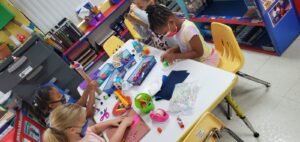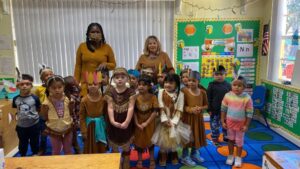Early literacy’s significance cannot be overstated in a child’s development journey. It forms the foundation for a lifetime of learning, equipping young minds with the essential skills to navigate the complexities of language, communication, and understanding.
Early literacy is not about early reading instructions or encouraging babies to read early on. It’s about letting skills develop naturally through enjoying books, positive interactions between babies and parents, and engaging experiences with language and reading.
At Creative Learning Experience, a preschool in lake worth, we want to help parents and caregivers delve into early literacy, exploring its importance, stages, and actionable strategies to foster a lifelong love for reading and learning.
What is Early Literacy?
Early literacy goes far beyond the basics of reading and writing. It forms the vital building blocks that pave the way for effective communication and lifelong learning. It’s not just about decoding words on a page; it’s about cultivating a rich understanding of language and text that sets the stage for a child’s educational journey.
Early literacy is a comprehensive set of skills that serve as a springboard for reading, writing, and meaningful interaction with the world around us. It encompasses diverse activities that collectively contribute to a child’s language development. The early literacy skills include:
- Singing: The melodic rhythm of songs captivates young minds, introducing them to the cadence and rhythm of language. Singing enhances phonemic awareness, a crucial skill for recognizing and manipulating sounds in words.
- Talking: Conversations with caregivers and peers enrich a child’s vocabulary, comprehension, and ability to express themselves. Engaging in dialogue fosters an understanding of sentence structure, grammar, and the nuances of language.
- Reading: Sharing stories with young children introduces them to the magic of words and narrative. This ignites their imagination and builds their comprehension skills as they learn to make connections and follow a storyline.
- Writing: Even before a child can form letters, they can engage in early writing activities like scribbling and drawing. These endeavors lay the foundation for later writing skills by enhancing fine motor control and hand-eye coordination.
- Playing: Play is a child’s natural mode of exploration and learning. Through imaginative play, children experiment with language, create narratives, and build vocabulary.
Components of Early Literacy
Several foundational components form a solid basis for a child’s future reading and language skills. These elements not only shape a child’s ability to decode words but also cultivate their creativity and aptitude for effective communication:
- Oral Language Development: Conversations and interactions build a strong foundation for language comprehension and communication.
- Phonological Awareness: This involves recognizing and manipulating language sounds, a vital reading skill.
- Alphabet Knowledge: Learning letters and their corresponding sounds is crucial for decoding words.
- Reading Comprehension: Understanding the meaning of written text is vital for compelling reading.
- Writing Development: Encouraging children to express themselves through writing fosters creativity and language skills.
Why is Literacy Important in Early Childhood?
Literacy development in early childhood forms the cornerstone of cognitive growth. It stimulates brain development, enhances vocabulary, and cultivates imagination. Early literacy is a springboard for a child’s success in school, facilitating improved comprehension, critical thinking, and communication skills as they progress through school and beyond.
This foundation helps children do better in school and life by improving their understanding, critical thinking, and effective communication. In simpler terms, early literacy acts as a powerful starting point for a child’s mental growth. It helps their brain develop, builds their vocabulary, and encourages them to imagine and explore.
As they embark on the journey of reading and writing, they are mastering the art of learning itself, which becomes incredibly valuable as they continue their education. So, the journey of early literacy isn’t just about letters and words – it’s about opening doors to a world of understanding and possibilities.
Stages of Early Literacy
The early literacy journey is an exciting progression marked by distinct stages, each bringing skills and achievements. As children grow and engage with the world of written language, they navigate through various phases that build upon one another. Let’s take a closer look at these developmental stages and the remarkable milestones they encompass.
Emergent Literacy
Children begin to recognize letters, words, and symbols at this stage. They exhibit curiosity about the written word and its meaning, showing an interest in books and print materials.
Alphabetic Fluency
Children now start to grasp the relationship between letters and sounds. They begin to decode simple words and understand that letters form the building blocks of words.
Words and Patterns
At this stage, they expand their vocabulary and start recognizing patterns in language. They can identify high-frequency words and begin constructing simple sentences.
Intermediate Reading
Kids develop the ability to read more complex texts with greater comprehension. They understand story structures, predict outcomes, and engage with narratives on a deeper level.
Advanced Reading
In this stage, children can read independently and understand various texts. They develop critical thinking skills, infer meanings, and analyze content.
How to promote literacy in early childhood?
Parents and caregivers are vital in nurturing a child’s literacy journey from the beginning, and this is something we care about in our programs. The early years are a precious time for shaping their language skills and fostering a deep connection with written words. Here are some actionable ways to actively promote literacy:
- Embrace Daily Reading: The power of reading aloud cannot be underestimated. When you read to a child every day, you’re sharing stories and introducing them to the rich tapestry of language. The rhythm and melody of your voice capture their attention, expanding their vocabulary and kindling a lifelong love for stories.
- Spark Conversations: Discussing the books and print materials you encounter adds another layer of understanding. Encourage your child to express thoughts, predict outcomes, and ask questions. These conversations nurture critical thinking and enhance comprehension skills.
- Music and Rhymes: Incorporating songs and rhymes into your daily routine is a delightful way to boost phonological awareness. Singing exposes children to the distinct sounds of words, helping them recognize and manipulate language sounds, a fundamental reading skill.
- Playful Learning: Turn learning into a game by playing activities that involve letters and sounds. From identifying letters in everyday objects to creating rhyming words, these interactive games make learning enjoyable and memorable, strengthening letter recognition and sound association.
- Encourage Writing Adventures: Providing opportunities for your child to experiment with writing fosters creativity and fine motor skills. Offer crayons, paper, and other writing tools, and let them explore the joy of putting their thoughts on paper.
Likewise, nurturing early literacy at home involves decisive practices that can significantly influence your child’s relationship with reading and writing. To begin, curate a print-rich environment by placing books, magazines, and labels within easy reach. This not only encourages exploration but also fosters familiarity with written language.
Setting a dedicated reading routine before bedtime or during meals establishes an anticipated time for bonding through stories. Embrace the power of storytelling by asking open-ended questions that spark your child’s imagination and engagement. Lastly, don’t forget to celebrate their reading and writing progress, creating a positive atmosphere that inspires their love for learning.
You create a supportive environment where literacy flourishes naturally by weaving these strategies into your daily interactions. Remember, your involvement and enthusiasm pave the way for your child’s lifelong appreciation for the written word.




